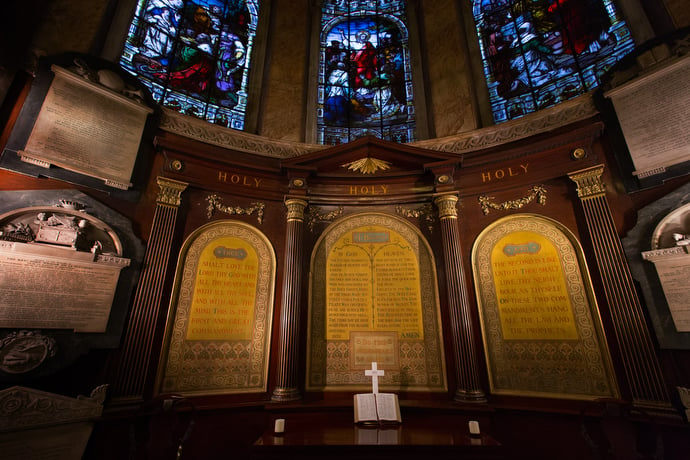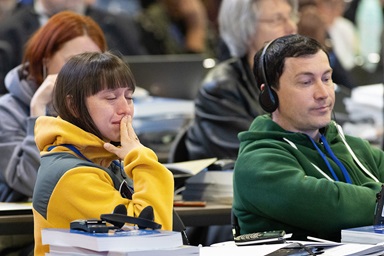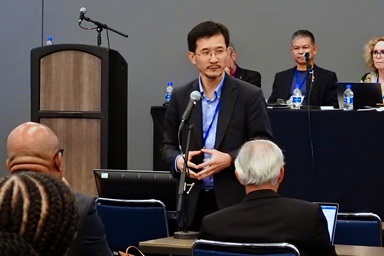The Anglican connection at Wesley’s Chapel is as old as John Wesley and as new as the Methodists who worship there today and their counterparts at St. Paul’s Cathedral.
For the Rev. Jennifer Smith, Wesley Chapel’s superintendent minister, the connection is also very personal. Her spouse, Keith Riglin, is a priest with the Church of England. He serves as assistant dean at Kings College and comes to services at the chapel once a month, sent by his bishop.
That assignment is because Wesley’s Chapel “is very significant” from an Anglican perspective, Riglin pointed out.
In February 2018, Smith was installed as an honorary ecumenical canon at St. Paul’s Cathedral, which is a mile away from the chapel. “It means that, in my person, I will be an expression of the covenant in mission that we hold,” she explained before that event occurred.
The position gives her a visible presence “in a large Anglican public ministry and affairs of state,” she said. “It’s not about status, it’s about a public representative role for the church.”
The first female Bishop of London, Sarah Mullally, will be installed at St. Paul’s on May 12.
Making history relevant today
 John Wesley's Communion Table is a central feature of Wesley's Chapel.
John Wesley's Communion Table is a central feature of Wesley's Chapel.
LONDON (UMNS) — With John Wesley’s study chair, Charles Wesley’s organ and the Museum of Methodism on-site, it would be possible to conclude that Wesley’s Chapel & Leysian Mission is stuck in time — the late 18th century, to be exact.
That is not the case.
The Methodist-Anglican connection throughout England is not just about worship, but about local interfaith action to fight poverty, support refugees and collaborate on other social justice issues. “These are partnerships of substance,” Smith added.
Evangelism also happens in partnership. In Cumbria, northwest England, Methodists are working closely with Anglicans, the United Reform Church and, more recently, the Salvation Army on a joint witness that includes reaching out to some of the millions of visitors who come to the Lake District national park and other scenic areas each year.
British Methodists were among the 34 ecumenical groups of lay people, youth workers, ordinands and clergy who took part in more than 200 “Moving Mountains” events northwest England in March. All of the events emphasized a key message: “God loves you more than you will ever know.”
The most recent formal agreement between Methodists and Anglicans was signed in 2003. “An Anglican-Methodist Covenant” was celebrated on All Saints Day that year, beginning with the official signing at Methodist Central Hall and continuing, across the square, with a dedication service at Westminster Abbey that included the presence of Queen Elizabeth.
Now a new agreement, “Mission and Ministry in Covenant,” is being considered by both denominations, says the Rev. Neil Stubbens, ecumenical officer for the British Methodists, with the hope that “it would help both churches to serve more effectively.”
The joint report on the agreement includes proposals that build upon prior commitments, including those made in the 2003 covenant, to enable a new depth of relationship and communion without merging the two churches.
For example, the new agreement would allow presbyters (ministers) and priests to be eligible to serve in both denominations. “Rather than simply switching in full-time appointments, it’s about serving in both — sharing in ministry without some of the overheads that we’ve got at the moment,” he explained.
Stubbens pointed out that the pooling of resources, including clergy, could be an advantage when the vast majority of churches in England are experiencing a decline. “We want to address how we share the good news with people in an increasingly secular society,” he said.
One of the significant changes for the Methodist Church, if accepted, would be the introduction “of the historic episcopate into our system,” he said, which would be accomplished by making the president of the Methodist Conference a “president-bishop.”
While a conference president only serves for one year, the clergyperson elected “would continue to exercise an episcopal ministry” after his or her term as president had ended, he added.
A report on the covenant’s proposals was released just before the 2017 Methodist Conference and discussed in workshops but not presented as part of the official conference business, Stubbens said.
In early February, the Church of England’s General Synod voted to “welcome” the joint report, which will now be further refined. The proposals are not expected to be brought to the Methodist Conference for discussion until 2019.
Bloom is assistant news editor of United Methodist News Service and DuBose is a photographer for United Methodist Communications. Contact them at (615) 742-5470 or [email protected]. To read more United Methodist news, subscribe to the free Daily or Weekly Digests
Like what you're reading? Support the ministry of UM News! Your support ensures the latest denominational news, dynamic stories and informative articles will continue to connect our global community. Make a tax-deductible donation at ResourceUMC.org/GiveUMCom.




